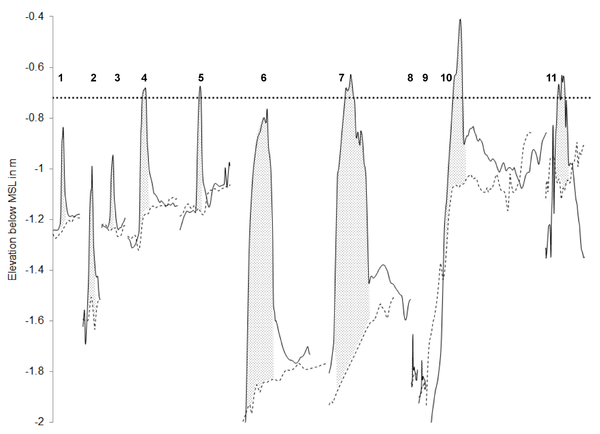| Positie oesterriffen Oosterschelde | |
|---|---|
| Context | Sedimentbalans en oesters in de Oosterschelde Oosterschelde |
| Type | Condition |
| Decompositie type | IOR |
Position of natural oyster reefs
Position is a parameter that influences the resilience of an oyster reef. There are indications that reef height is limited by exposure time. As demonstrated in Figure 1, the top of the reefs were on average 0.72 ± 0.16 meters below Mean Sea Level (MSL) (excluding the two smallest reefs (no. 8 and 9) which are considered not fully developed reefs at present). This corresponds with an inundation time of 4 hours (33%) per low tide within the semi-diurnal tidal cycle of the Eastern Scheldt. In line with this finding, reef heights differ at different locations in the intertidal area. Reefs located low in the intertidal are higher than reefs located high in the intertidal, indicating possible growth restriction up to a certain height (exposure time). Reef height however also shows strong correlation with reef length (R2=0.87), width (R2=0.94) and reef area (R2=0.93) which could indicate that reef height is part of a characteristic reef shape rather than a result of growth restrictions. Although oysters can settle in a wide range of places, as long a hard substrate is available, the profiles of Rijkswaterstaat in Figure 1 show that oysters preferentially settle low in the intertidal, often near intertidal channels or after the settlement, the oyster reefs will promote channel formation, especially at the edges of the reefs. (Walles et al., 2014).

Position of artificial oyster reefs
The fact that oyster reefs will promote channel formation, especially at the edges of the reefs (Figure 1), is very interesting and important when constructing artificial reefs in the Eastern Scheldt. It demonstrates that artificial reefs should be constructed preferentially low in the intertidal, as here the chance of developing a living oyster reef will be the best. The fact of the oysters settle in the lower intertidal areas also make the use of these ecosystem engineers a suitable method due to the fact that the artificial reef will also be located in these areas in order to prevent the sediment from moving to the channels (Walles et al., 2014).
De View-Navigation (VN) pagina's.
De links naar andere pagina's.
| Onderdeel van | |
|---|---|
| Instantie van | |
| Betreft |
Draagt bij aan.
| Draagt bij aan | Sedimentatie Oosterschelde |
|---|---|
| Waarde | + |
| Opmerkingen |
De pagina's die linken naar deze pagina.
Dit element heeft geen subelementen.
| Komt van | Type | Connectie type | Conditie | Waarde | Opmerkingen |
|---|---|---|---|---|---|
| Programma van eisen oesterriffen Oosterschelde | Depends | afhankelijk van |






